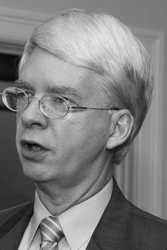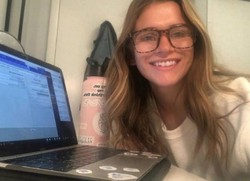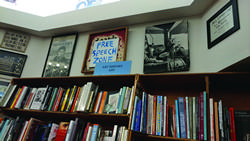As busy members of the Universi-ty community, we sometimes forget all of the work that goes behind find-ing our professors, organizing our esteemed curriculums, and financ-ing our residence halls and extracur-ricular activities. However, standing behind all of these imperative deci-sions is Provost Thomas Pearson, Vice President for Academic Af-fairs, who is the longest standing Provost in the Northeast.
Pearson’s specialization is in Rus-sian history, which he said interests him because, “It’s a land of fascinating paradoxes. It is the largest landmass in the world, a history of strong state power, and yet people are still able to evade it and challenge it.” He said that even when he was young, flip-ping through an atlas, Russia always had a “mystifying” quality to it that he was attracted to. Plus, he grew up dur-ing the 1960’s, the Cold War period, which only increased its perplexing characteristics.
He went on to study Russian history as an undergraduate at Santa Clara University, and then as a graduate and doctoral student at the University of North Carolina.
However, Pearson did not ever in-tend to hold the position of Provost. In 1978, he started as an assistant Russian history professor, brought forth from Auburn University to Monmouth College in search of the ability to develop as a teacher. When Pearson was hired at Monmouth in 1978, the then-college was facing some tough times as the faculty went on a two-week strike in 1979, which led to the removal of President Rich-ard J. Stonesifer. Dr. Samuel Magill succeeded him in 1980.
Following his hiring, Pearson served as History Department Chair, Chair of the Academic Policy Com-mittee, Director of the Honors Pro-gram, Coordinator of Graduate Stud-ies, and Chair of Faculty Council, among other positions.
After four years at the University, Pearson stepped down as History De-partment Chair so that he could work on his second book. Two weeks later, in 1981, Magill asked him to be his Provost for the remaining year.
He accepted the job, thinking that it was temporary and he could try his hand at it. Thirty-one years later, Pear-son still holds the position as Provost. Throughout his time here, Pearson has seen the University go through many changes. Starting out, Pearson said Monmouth had quite a few issues to deal with in 1978. “The campus was in very poor condition. The finances were troubled. The enrollment and quality of students was way below what we have now, and there was a lot of worry of month-to-month how Monmouth College would survive. It was pretty desperate. I even won-dered, when I first got here, what I was doing here in the first place,” he said.
Throughout the drastic positive turnaround that the University has gone through, Pearson said that his proudest accomplishment is, “We have become a university that is ma-ture, respected, and has a strong aca-demic reputation.” This ties in with the strong Centers of Distinction that exist throughout the campus, such as the Urban Coast Institute, the Rapid Response Institute, Kislak Real Es-tate Institute, the Polling Institute, and the various schools and pro-grams that exist throughout.
One of the many jobs of the Pro-vost is to manage all affairs concern-ing the faculty. Pearson hires faculty members, reviews them for continu-ance, and determines if they will re-ceive tenure or receive a promotion. In order to make the most responsible decisions for the University commu-nity, he works with the faculty coun-cil.
Dr. Kevin Dooley, Honors School Dean and former student of Pear-son’s, said, “Working with the Pro-vost as a member of the Academic Affairs Planning Group (AAPG) has convinced me that he always leads with what is best for the academic reputation of the University. He also always takes others’ opinions into consideration when making a deci-sion. His best quality is his ability to eloquently convey a point in the most respectful manner to students and faculty who might be in a state of dis-agreement.” Pearson also develops programs and curriculums, accredits all programs, and plans budgets. Ev-ery academic department reports to the Provost, making him the key to keeping the entire University system moving in a stable direction.
In order to manage such responsi-bilities, one must be a careful plan-ner, which Pearson considers himself to be. Even with careful planning, however, being Provost brings about new unforeseen issues constantly. He said, “Just about every day, a chal-lenge comes about that I had not anticipated.” If he had to describe his job in one sentence, he would say, “Busy all the time.” The biggest chal-lenge of being Provost, according to Pearson, is managing the reduction of resources due to the economic down-turn. In 2007, the University received three and a half million dollars in aid from the state, which has been zeroed out because of the monetary crisis. The issue becomes how to not only create quality programs, but also continue to develop those programs with three and a half million less dollars.
“We don’t have big debt like other institutions do. In terms of quality, we have gotten great reviews and we are now being used as a model for other institutions. Plus, at 78-years-old, we are still very young compared to other schools,” he said.
The Provost said that this is also what the biggest misconception in his position is; that he has “deep pockets.” He said, “This is different than it was from when I started. Now we have to ask ourselves, ‘Do we need this position?’ ‘What can we do with this space?’”
However, with these challenges, Pearson deals with a great amount of stress. “Anyone who has been doing a job like this for 20 years begins to feel a bit of fatigue from time-to-time, but I think what is good now is that I have a lot of experience. I also have wonder-ful family and colleague support. The people in this office are unbelievable with working with me and keeping me on track. There are times when I think, though, ‘What day of the week is this?’”
One thing that he finds helpful is to work with other divisions to solve problems. Pearson said, “I find that in life if you just try to do it your-self, you’re not going to get as far as you will when you work with others because you’re not getting a broader scope of ideas.” This is part of the job that interests Pearson the most. He said that he is always trying to figure out how the University can get to the next level, how we can get the right people working here, and how we can get the resources that we need.
“It’s been very enjoyable to see the University develop as it has,” he said. “When we began to build up enroll-ment, we had resources and money that came in and we had to decide do we want to use this or invest it? It was a lot of that thinking that allowed us to put money back into the campus presence.”
Even though it is a tremendous amount to manage and plan, Pearson said, “I have my moments when I feel everything is collapsing and crazy. Being a historian, I often think about the changes here and my time here has coincided with what the Soviet Union went through. That’s a much bigger change and a much more catastrophic one, but for us, its been largely an onward and upward pro-gression.”
However, Pearson’s career as Pro-vost has not been without regrets. He said, “Back in the early 2000’s when we were doing really well with enrollments, we missed an oppor-tunity to price ourselves with an in-crease in tuition, which would have led to more money to flow back into academic programs. So now we are looking to correct our pricing, but we are in an economic crisis that doesn’t allow us to.”
This was not solely the Provost’s call, but he feels that he should have pushed harder so that conditions to-day would be easier. Normally, there is a four percent increase in tuition per year, making the University above the middle line of private in-stitution tuition in the early 2000’s. Now, we are in the bottle third for tuition rates.
“For what we represent and the quality of the experience, it’s not good to be in the bottom third. We want to be close to the middle, but it’s hard to get there due to the economic conditions. We should have done five and a half percent increases in tuition for a few years,” he said. One of Pearson’s goals in the next five to 10 years is to see Monmouth become a national leader in its programs, as it is already a leader in many programs on a state basis. We are already well on our way, being that nationally, the School of Social Work is in the Top 100, the School of Business is in the Top 280, and the Department of Communication is becoming very strong. Also, Monmouth holds one of the only undergraduate software engineering programs in the coun-try.
On the same note, Pearson hopes to continue educating students with teacher-scholars, who continue to produce and publish high quality work and research while teaching students. One of Pearson’s proud-est accomplishments was decreas-ing the professor course load so that professors had more time to publish work and superior professors could be hired. “We can always continue to do better,” Pearson said. “We should continue to stretch ourselves, since when you’re stretched, you feel good at what you accomplished and you feel better about taking the next step. In the working world, you’re going to be stretched all the time. There aren’t many free rides any more.” Pearson said that it dis-tresses him when he hears that stu-dents say they graduated Monmouth easily, since that means that students are depriving themselves of a true undergraduate experience.
“People always say it’s the best time of your life, but that depends on the circumstances. You never have an opportunity like you do in these four years to explore who you are and to tap into something of in-terest,” he said. The Provost teaches one course a semester, which he says helps him “keep pulse with the stu-dents and faculty” and is his “energy source.”
Tom Morton, who took Russian history I and II with Pearson, said that he only took the class because Pearson has such a strong passion for it, which makes the class exciting. Morton said, “I find him to be enthu-siastic about Monmouth, which I see mirrored in his enthusiasm for Rus-sian history.”
Pearson said, “I think it’s pretty good if you can say that after 40 years studying a subject, you’re still excited to continue with it. I’m still learn-ing new things about it. Plus, I love working with the students. It’s a cli-ché that the students keep you young, but if you really love what you do, you can handle a lot of things well. And, teaching sometimes gets me out of another meeting.”
Correction:
In the 1/25 issue of The Outlook, an article on Provost Thomas Pearson was printed with some inaccurate dates. The correct dates are as follows:
The Provost became the History Department Chair in 1981 and served in that role until 1992, with the exception of the academic year 1988-1989 (when he was on sabbatical for fall 1988). He began his service as Provost in 1992 and is in his 20th year (not his 31st the story indicates).
PHOTO COURTESY of Jim Reme




